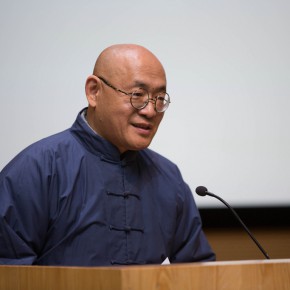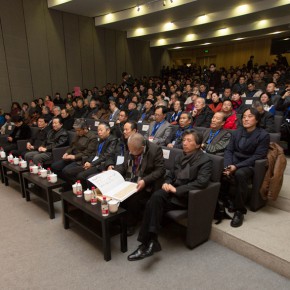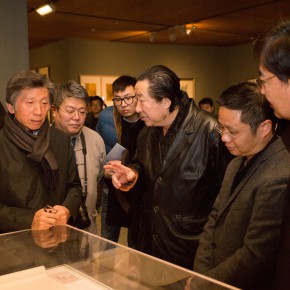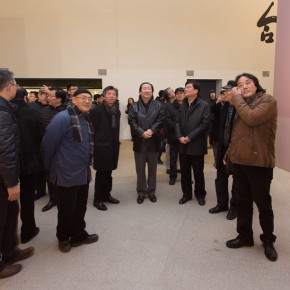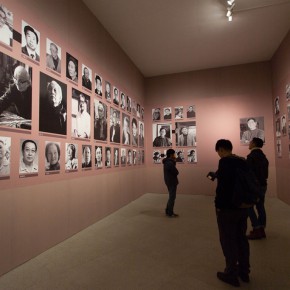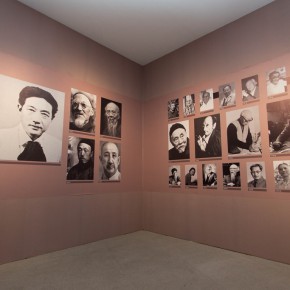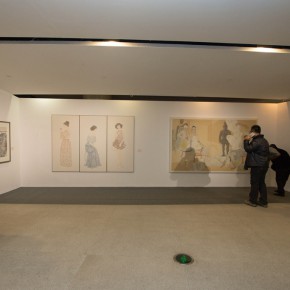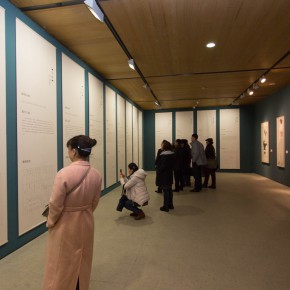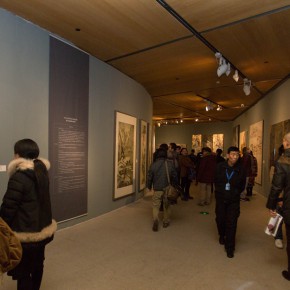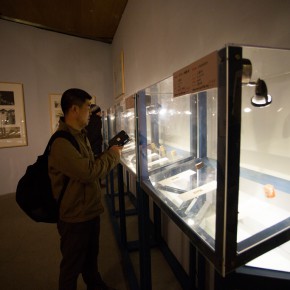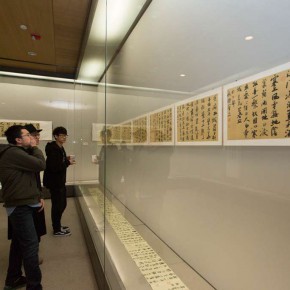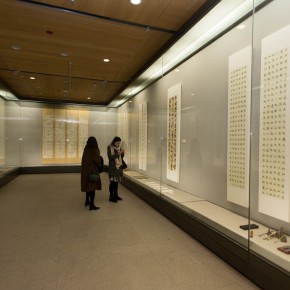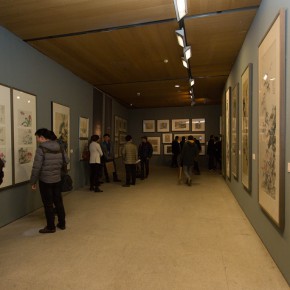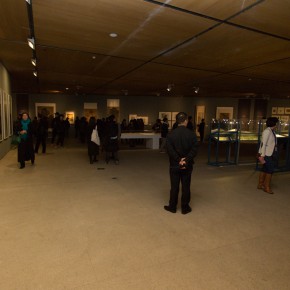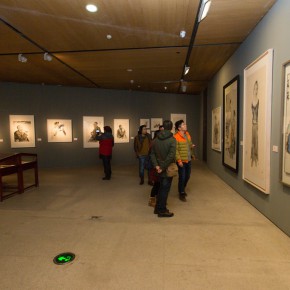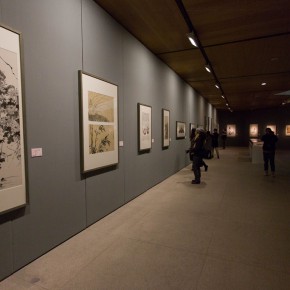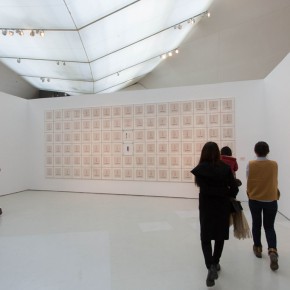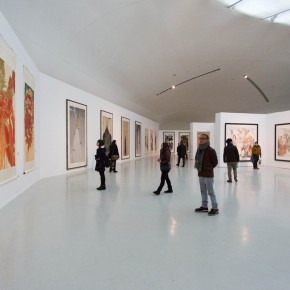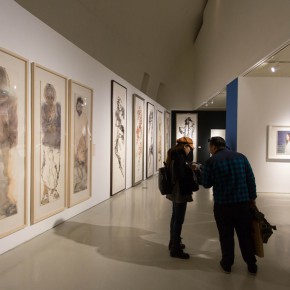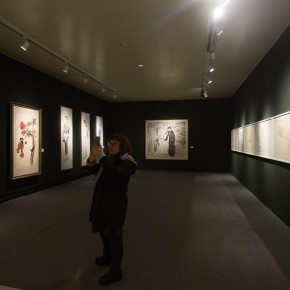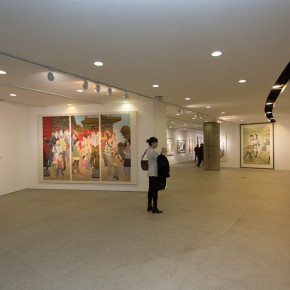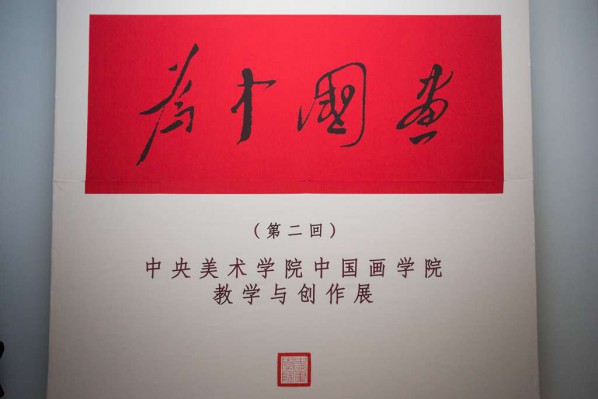
As an important exhibition for the circle of Chinese painting and the art education in 2015, “For Chinese Painting (Round II) – Exhibition of Teaching and Creative Achievements from the School of Chinese Painting, CAFA” was grandly unveiled at CAFA Art Museum on December 4, 2015. A previous exhibition with the same theme was held at the National Art Museum of China five years ago, and it is the second time for CAFA to hold the exhibition to present the status quo as well as the comprehensive status in teaching, creative achievements and research of Chinese painting in CAFA. The exhibition is hosted by CAFA, undertaken by the School of Chinese Painting, CAFA, co-organized by CAFA Art Museum and President of CAFA Fan Di’an serves as the Chief Curator.
It is a large-scale exhibition, concerned with the old, middle-age and young artists from Chinese painting circles, the honored guests and leaders who were present at the opening ceremony of the exhibition included: President of the China National Academy of Painting Yang Xiaoyang, Executive Vice President of the China National Academy of Painting Lu Yushun, Director of Prince Gong Mansion Management Center at the Ministry of Culture Sun Xuguang, Chairman of China Artists Association Li Xiang, Deputy Dean of the China National Academy of Arts Tian Liming, President of Shandong University of Arts, Chairman of Shandong Artists Association Zhang Zhimin, Vice President of China Academy of Art Wang Zan, Deputy Dean of Beijing Fine Art Academy Yuan Wu, Vice President of Minzu University of China and Dean of the School of Fine Arts Yin Huili, Vice President of Beijing Institute of Graphic Communication Tian Zhongli, Executive Vice President of the Academy of Chinese Painting at the Central Research Institute of Culture and History Ma Xinlin, etc., the leaders from CAFA included President of CAFA Fan Di’an, Party Secretary Gao Hong, Deputy Party Secretaries Sun Hongpei, Wang Shaojun, Assistant to the President of CAFA Lu Bin, Assistant to the President of CAFA and Dean of CAFA Office of Academic Affairs Wang Xiaolin. In addition, the old professors from CAFA and the participating artists such as Jiang Caiping, Jin Hongjun, Wang Tongren, Zhang Lichen, Hu Bo, Xie Zhigao, Tang Yongli, Liu Xilin, Du Dakai, Liu Jude, Wang Yinchun, etc., also attended the opening ceremony of the exhibition. Deputy Dean of the School of Chinese Painting, CAFA Yao Mingjing hosted the opening ceremony of the exhibition.
President Fan Di’an addressed the opening ceremony and said that the second round of the exhibition was held because the overall literary and artistic creation of this period, the situation of development both changed, the education of the school of Chinese painting had a new accumulation, the academic idea had been profoundly changed and it coincided with the “Hundred Years of Glory” celebration planning, so that the theme of the exhibition “Starting, Inheriting, Innovation and Integration” was put forward. “Starting” referred to the starting point for the teaching of Chinese painting; “Inheriting” referred to the heritage of the professional tradition skills, at the same time, it also inherited learning and cultivation of Chinese culture; “Innovation” was better absorbed from the present life experience on the basis of inheriting”, which made the traditional experience transform into creation; “integration” was about opening and closing, fusion and comprehensive ability, the creation of the teachers should reflect the broad cultural vision and mind of today.
Dean of the School of Chinese Painting, CAFA Chen Ping composed a poem for the opening of the exhibition, to sort out the developmental history of the School of Chinese Painting as well as the academic origins of various disciplines of Chinese painting. Vice President of China Academy of Art Wang Zan addressed the opening on behalf of the brother universities and colleges, he started from the different academic perspectives chosen by CAFA and the China Academy of Art, he interpreted a suitable road for current Chinese painting. Since Xu Beihong and Lin Fengmian’s era, CAFA and the China Academy of Art have respectively moved toward different veins including realism and expressionism, and their different developmental paths implemented the diversified development of teaching and creation. The two academies should commonly face the problems in personnel training, teaching innovation, research and creation of the subject, and shared the responsibilities together, mutually thinking of how Chinese painting advanced towards global developments, how to construct a set of Chinese painting creations led by Chinese modern culture and thought. At the same time, Wang also pointed out the artistic creations of all the academies of fine arts which were more and more lacking in a personalized language, which was also a problem for us to solve together.
Chinese painting is the artistic accumulation of Chinese traditions and also one of the earliest established professions of CAFA. The School of Chinese Painting, CAFA was officially established in 2005 on the basis of the previous Department of Chinese Painting, CAFA, in order to adapt to the changing new cultural state of the new period. In order to constantly summarize the teaching experiences and encouraging academic exploration, featuring the creative and research results. For the Chinese Painting series of exhibitions which are launched by the School of Chinese Painting, CAFA. The exhibition takes “starting, inheriting, innovation, integration” as the academic theme, to both showcase the characteristics of the discipline of Chinese painting and research the origin and genres of the teaching, creation and research of Chinese painting, the inheritance and change, thinking about the teaching development of Chinese painting in the past and future. “Starting, inheriting, innovation and integration” is similar to the commonly used structural techniques for artistic creation, referring to the writing skill of an article, while it coincides with the structure of composition and schema in the painting laws and methods of the Chinese painting creation. Chinese painting stresses the virtual and real, vigor, management, layout and location. Between a line and dot, it has “starting, inheriting, innovation and integration”. At the same time it is also the four dimensions of the creation, teaching and research of Chinese painting, “starting” means the starting point, standing up, origin, “inheriting” means undertaking and inheritance, “innovation” means innovating, transforming, raising, “integration” means being comprehensive and offering fusion. For “Chinese Painting” is to inherit one hundred years of tradition and the internal discussion of the ontology of Chinese painting, for “Chinese painting” actively faces the new cultural context of Chinese art and constantly offers a definition of the future development path and direction of the discipline of Chinese painting.
On the opening day, it synchronously launched the related academic seminar entitled “Teaching and Development of Chinese Painting”, the exchange symposium entitled “Teaching of Chinese Painting at the Colleges and Universities of Art in China”, which invited the related influential and representative artists, theorists and experts in the field of Chinese painting teaching in China together to discuss the teaching practice, creation and research of contemporary Chinese painting.
The exhibition continues to December 22, 2015.
Text by Zhang Wenzhi, Photo by Yang Yanyuan/CAFA ART INFO
Translated by Chen Peihua and edited by Sue/CAFA ART INFO



